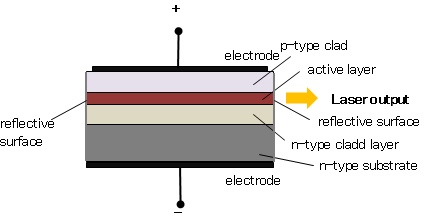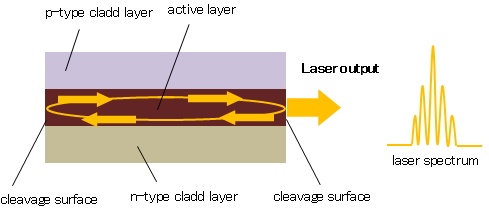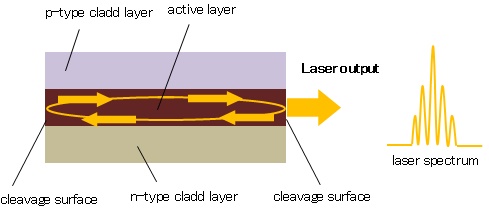Last updated on 05/7/2021
A semiconductor laser (LD) is a device that causes laser oscillation by flowing an electric current to semiconductor.The mechanism of light emission is the same as a light-emitting diode (LED). Light is generated by flowing the forward current to a p-n junction. In forward bias operation, the p-type layer is connected with the positive terminal and the n-type layer is connected with the negative terminal, electrons enter from the n-type layer and holes from the p-type layer. When the two meet at the junction, an electron drops into a hole and light is emitted at the time.
The basic structure of a semiconductor laser is shown in Figure 1. The active layer (light emission layer) sandwiched between the p- and n-type clad layers (double heterostructure) is formed on an n-type substrate, and voltage is applied across the p-n junction from the electrodes. Both edges of the active layer has mirror-like surface.When forward voltage is applied, electrons conbine with holes at the p-n junction, and emitt the light. This light is not a laser yet; it is confined within the active layer because the refractive index of the clad layers are lower than that of the active layer. In addition, both ends of the active layer act as a reflecting mirror where the light reciprocates in the active layer. Then, the light is amplified by the stimulated emission process and laser oscillation is generated.

Figure 1: Basic structure of semiconductor laser
The center wavelength of a semiconductor laser principally depends on the band gap energy of the active layer semiconductor. However, the details of laser spectra are different depending on the LD types even though the band gap energies are same.
This laser has the simplest structure and is used for many applications, including optical pickups for CDs, DVDs, and BDs; laser printers; and excitation of fiber lasers. It is characterized by the use of the cleavage plane of a laser crystal for reflection of the light emitted in the active layer, as shown in Figure 1. A cleavage plane of a crystal is extremely smooth and can be used as a reflecting mirror. Since Fabry perot-LD has no mechanism to select a specific oscillation wavelength, the multiple laser oscillation occurs within the gain bandwidth as shown in Fig.2. The oscillation at multiple wavelengths causes pulse broadening in an optical fiber transmission, and therefore it cannot be applied for long-distance communications.

Figure 2: Schematic diagram of Fabry-Perot type semiconductor laser
The DFB laser (Distributed Feedback Laser) has a grating below or above the active layer, and oscillates at the single wavelength defined by the Bragg wavelength of the grating. Figure 3 illustrates the structure outline. It exhibits superior performances, including a narrow spectrum width and low noise, and hence is used as an optical signal source in a long-haul optical communication.

Figure 3: Schematic diagram of DFB type semiconductor laser
Though DFB laser has an excellent performance like a single wavelength oscillation, it is expensive for manufacturing difficulty. More economical laser to oscillate a single wavelength is a laser diode stabilizing the wavelength by using FBG. Figure 4 illustrates the structure outline. In this case, the laser cavity is composed of the HR coated end face of the active layer and the low reflectance FBG. In figure 4, the fiber core only is drawn. The other end face of the active layer and the incident end of the fiber have AR coating to prevent reflecting light. In addition, the incidence end of the fiber is processed to a lens configuration to collect the light. Since the FBG formed in the fiber core only reflects a specific wavelength, a single wavelength oscillation occurs.

Figure 4: Schematic diagram of FBG wavelength stabilized semiconductor laser
FiberLabs offers the following products related to this article. Please visit these pages if you are interested in this article.